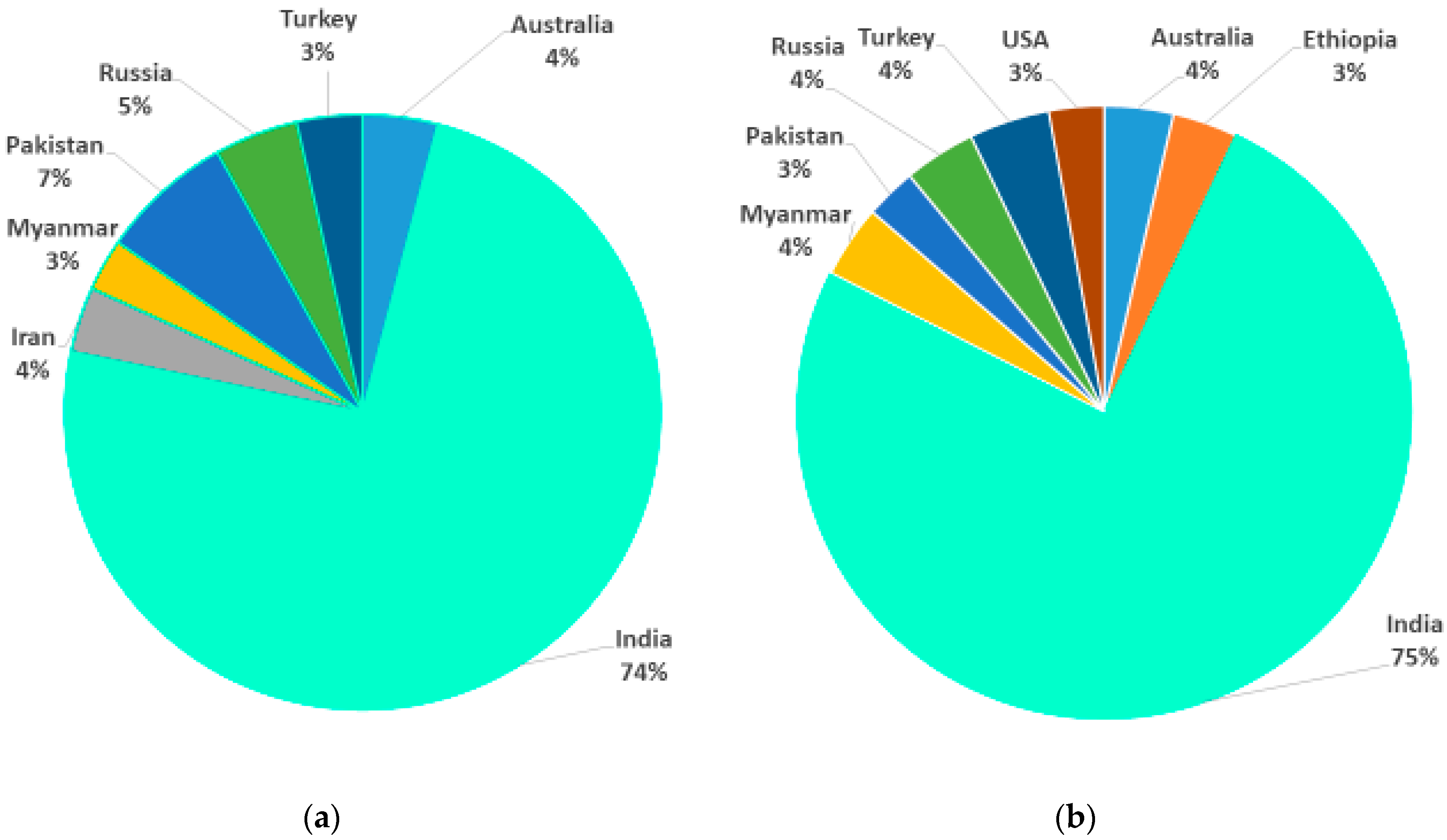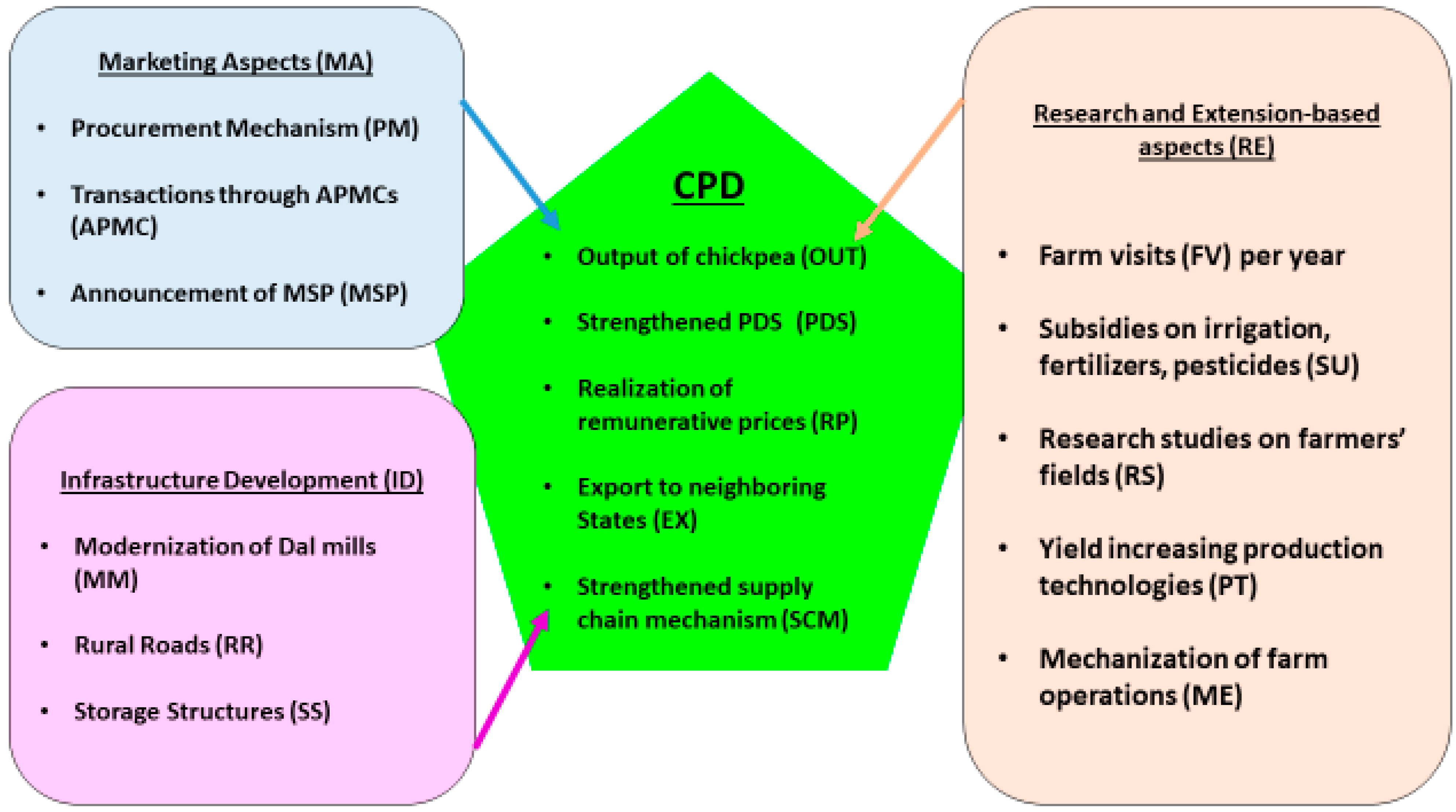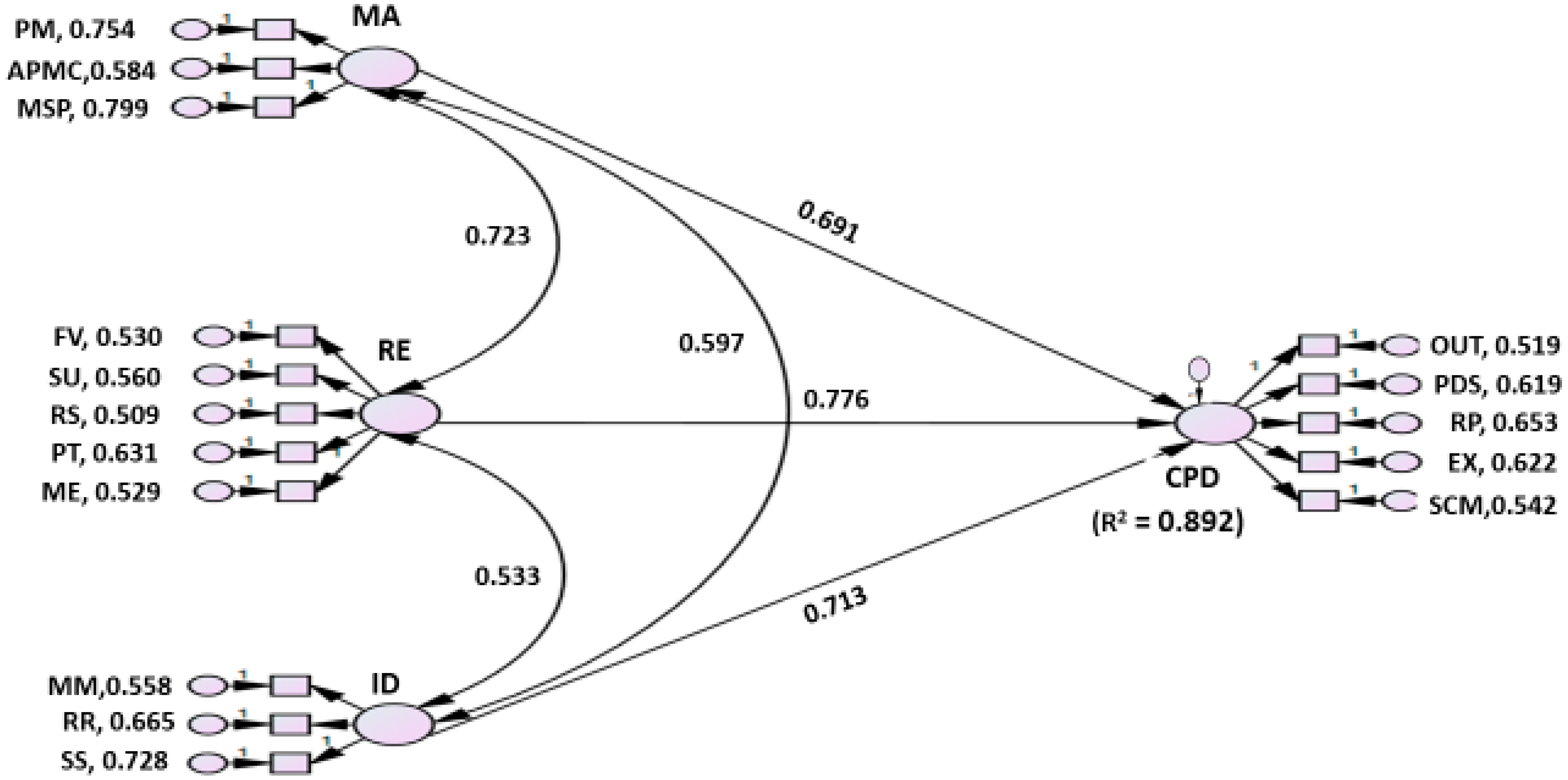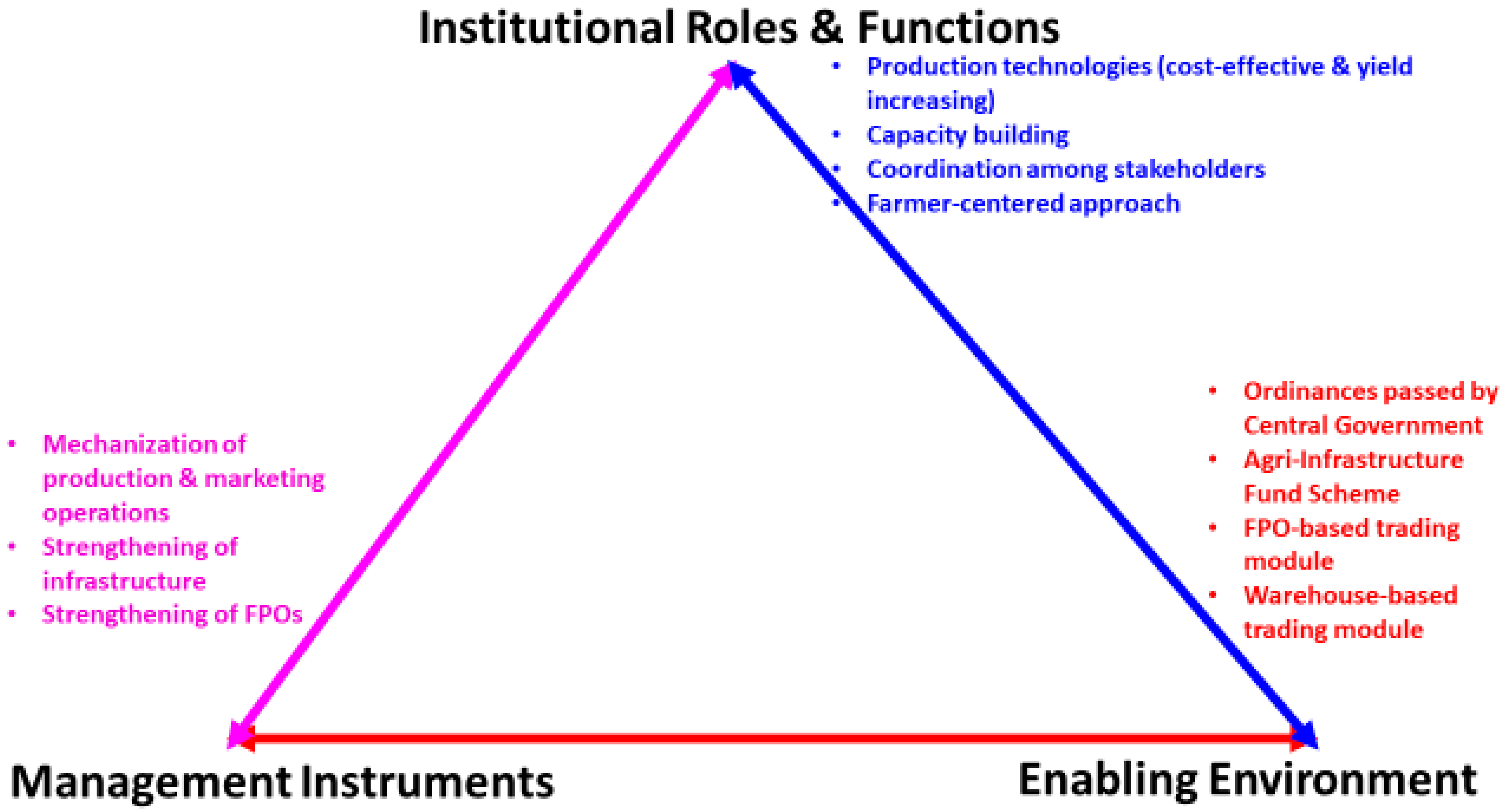1. Introduction
Legumes, also known as pulses, constitute an integral component of a sustainable crop production system as they contribute high-quality protein, free atmospheric nitrogen, can be cultivated under irrigated/dry conditions with low water requirements, are highly remunerative to farmers, and have persistent increasing demand from consumers. In 2018, the world production of pulses was around 92 m. tonnes, and the production increased drastically by about 63 per cent during 1998–2018 compared with only a 12 per cent increase from 1978 to 1998 [
1]. Substantial increases have been observed in the production of common beans (+14 m. tonnes), chickpeas (+8.3 m. tonnes), lentils and pigeon peas (+3.6 m. tonnes each), cowpeas (+3.5 m. tonnes), and dry peas (+1.2 m. tonnes) at a global level. In terms of regions, production increased by 17.3 m. tonnes in Asia (with South Asia contributing a 69% share), 10.5 m. tonnes in sub-Saharan Africa, 4.8 m. tonnes in North America, and 2.2 m. tonnes in Latin America and the Caribbean [
2]. This growing popularity of pulse production during the most recent decades, 1998–2018, is due to the adoption of improved varieties, plant protection aspects, advances in farm mechanization and production technologies, rise in international prices, etc. These factors coupled with increasing demand for pulses in the international market have led to favorable terms of trade across countries such as the USA, Canada, and Australia [
3].
India leads in production, consumption and import of pulses during the triennium ending (TE) 2019, and it accounts for 37 per cent and 27 per cent in terms of global area and production, respectively. However, India lags in terms of productivity of pulses, with only 707 kg/ha (ranked 137th in the world) compared with a global average productivity of 1479 kg/ha during TE 2019. Ireland (4695 kg/ha) enjoyed the highest productivity in the world followed by Belgium (4211 kg/ha), the Netherlands (4049 kg/ha), Tajikistan (3683 kg/ha), and Denmark (3637 kg/ha) during TE 2019 [
1]. Consequently, the pulse production in India during 2019 was 23.40 m. tonnes, which was 9.8 per cent less than the targeted 25.95 m. tonnes [
4].
In India, there is a declining contribution of pulses among total food grains in terms of shares in the area, production, and productivity during the reference period, 1950–1951 to 2018–2019 (
Table 1). This implies that there has been no breakthrough in pulse production technologies as compared to other commodities (cereals especially) of food grains. Due to low productivity, the pulse production in India has not kept pace with the growth of population, leading to their declining per capita availability (
Table 2). The per capita per day (gm/day) and per capita per year (kg/year) availability of pulses has dwindled between 1951 and 2019, implying that rapid growth in population has affected the availability of pulses on a per capita basis [
4]. These trends have been recognized for a long time and have prompted the Government of India to introduce various programs such as the Pulses Development Scheme during IV Five Year Plan (FYP) (1969–1970 to 1973–1974), National Pulses Development Project (NPDP) during VII FYP, Special Food Grain Production Programme (SFPP) on Pulses during 1988–1989 on a 100 per cent Central Assistance basis, Integrated Scheme for Oilseeds, Pulses, Oil palm and Maize (ISOPOM) during 2004–2005 to 2009–2010, and National Food Security Mission (NFSM) during XI and XII FYPs [
3].
India is also the leading producer of chickpeas with an 11.23 per cent share in global pulse production [
4]; chickpeas were cultivated in around 9.91 m. ha with a production of 10.23 m. tonnes during TE 2019. India contributed 74 per cent of the total area and 75 per cent of the total production of chickpeas in the world during TE 2019 (
Figure 1a,b). The major chickpea-producing countries in the world were India followed by Turkey (0.58 m. tonnes), Myanmar (0.52 m. tonnes), Russia (0.51 m. tonnes), Australia (0.49 m. tonnes), Ethiopia (0.46 m. tonnes), USA (0.39 m. tonnes), and Pakistan (0.37 m. tonnes) [
1]. Jordan enjoyed the highest productivity of chickpeas (5888 kg/ha) in the world, while India ranked in 29th position in the world in terms of productivity with 1031 kg/ha, which was less than the global average (1577 kg/ha), during TE 2019. Madhya Pradesh, Rajasthan, and Maharashtra are the leading chickpea-producing states in India, accounting for 43.29 per cent of total pulse production. The highest productivity of 1344 kg/ha is in Madhya Pradesh followed by 1324 kg/ha in Gujarat, 1272 kg/ha in Uttar Pradesh, and 1103 kg/ha in Rajasthan. However, the average productivity of chickpeas in India is low with 1031 kg/ha compared with the global average of 1577 kg/ha during TE 2019, as 65 per cent of the total cultivated area is under rainfed conditions and the remaining (35%) under critical irrigation support. Though the productivity of chickpeas is comparatively low, India is the leading producer in the world. However, due to stagnant productivity over the years (2001–2002 to 2016–2017), chickpea imports have been increased considerably to counterbalance its limited domestic supply. Hence, India became the leading importer of chickpeas (0.98 m. tonnes, accounting for 17.5% of total pulse imports) during 2017–18 [
4]. The countries that export chickpeas to India are Canada, Australia, Iran, Myanmar, Tanzania, Pakistan, Turkey, and France. Among pulses, chickpeas contribute the single largest share in India’s export market, registering 80.02 per cent during 2019 [
4]. Further, India is also a major exporter of chickpeas ranking third, i.e., 0.21 m. tonnes during 2019 [
1], and its export destinations are the USA, UK, Saudi Arabia, UAE, Sri Lanka, and Malaysia.
However, the cultivation of chickpeas is not very attractive for farmers in India because of both technology and policy shortcomings. Regarding technology, there is a dearth of short-duration, high-yielding, and drought, pest, and disease-resistant varieties of chickpea. Despite the execution of the various programs mentioned earlier, their continuation to the farmers’ fields has been limited. With regard to policy, the minimum support prices (MSP) for chickpeas announced by the Government of India showed a drastic increase from Rs 1200 to Rs 4875 (306.25 per cent) during 2001 to 2019 [
4]. However, this rise in MSP does not benefit the farmers because of two reasons. First, the procurement of chickpeas by government agencies is not as wide as that of cereals and especially the smallholder farmers with low marketable surplus are selling their produce in local markets for immediate cash requirements [
5]. Therefore, even if the prices of chickpeas rise during the lean marketing season, this benefits the traders more than the farmers, as traders have the capacity to store. The second reason is that the availability of modern production technology, the marketing infrastructure, and the research and extension network are weak. Added to this, supply chain bottlenecks further aggravate the problems of farmers. Further, due to increasing irrigation water and electric power scarcities, changing research priorities, declining domestic and export market competitiveness of chickpeas, and increasing emphasis on supply chain mechanisms, the new millennium has posed various challenges to the development agenda for CPD in India [
3]. As chickpea productivity in India (1031 kg/ha) was very low compared with Jordan (5888 kg/ha), China (5382 kg/ha), Israel (4242 kg/ha), Sudan (4048 kg/ha), Egypt (2410 kg/ha), Argentina (1961 kg/ha), and the global average (1577 kg/ha) during TE 2019, its production is not on par with the increasing demand [
6]. This requires a holistic approach towards CPD in India. The Agreement on Agriculture (AoA) of the World Trade Agreement sets out a number of general and measure-specific criteria which, when met, allow measures to be placed in the Green Box [
1]. Therefore, measures such as research, extension, marketing, investments, and price support to farmers, offered by the government, can be exempted from reduction commitments and, indeed, can even be increased without any financial limitation. This is considered important because the Government of India is spending millions of rupees to ensure self-sufficiency in pulse production in general and chickpea production in particular. Besides this, the identification of various issues pertaining to research and extension (RE)-based aspects, infrastructure development (ID), and marketing aspects (MA) highlighted in
Figure 2 and an understanding of their role in contributing to CPD in India have become a necessity to improve both cost effectiveness and profitability. Prioritizing the above three exogenous variables and their corresponding indicator variables is very much essential to promote CPD. However, to ensure this, we need to follow a holistic approach for analyzing and evaluating the above variables across the major chickpea-cultivating states in India. This will help to understand the intricacies of the system and to analyze in advance the effects of changes in various variables on the outcome variable (CPD). Accordingly, this in-depth study is proposed with the following specific objectives:
To examine the association between exogenous latent variables and their corresponding indicator variables towards contributing to CPD (endogenous latent variable) in India.
To evaluate and prioritize the contributions of both exogenous latent variables and their corresponding indicator variables in CPD using structural equation modeling (SEM).
To suggest policy measures that contribute to CPD in India.
Accordingly, this study identified three major areas of intervention: research and extension (RE), marketing aspects (MA), and infrastructure development (ID) to ascertain and prioritize their contribution to CPD through employing SEM. The remainder of the article is structured as follows: The next section presents a brief literature review on applications of the SEM technique, followed by a section that discusses the conceptual framework and hypotheses. The methodology, sample size, and SEM technique are discussed in the fourth section. The results of the study are discussed in the fifth section. Finally, concluding remarks and suggestions for future research are presented in last section.
2. Literature Review
SEM is useful for understanding the structural linkages between a set of latent variables that contribute to the trends in actual variables. These linkages can help in identifying the policy variables that could influence the outcome variables a policy maker is interested in and in prioritizing investments. Asadi et al., 2013 [
7] in their study analyzed the effects of ecological, social, and economic factors on sustainable agricultural development in Qazvin Province of Iran. Their study revealed that ecological sustainability had a greater impact on agricultural sustainability (0.642) than economic (0.604) and social (0.568) sustainability. They showed that SEM could be helpful for agricultural planners in identifying appropriate policies and monitoring the effectiveness of policy interventions.
Rohaeni et al., 2014 [
8] analyzed the sustainability of cattle farming using SEM in Tanah Laut Regency, South Kalimantan, Indonesia. They selected seven exogenous variables (environmental, economic, social, technology, physical, human, and institutional resources) and two endogenous variables (cattle farming sustainability and welfare of farmers) in formulating an SEM model. The findings revealed that environmental, economic, technological, physical, human, and institutional resources influenced the sustainability of beef cattle farming; environmental, economic, technological, physical, human, and institutional resources influenced, either directly or indirectly, the welfare of farmers; and cattle farming sustainability influenced the welfare of farmers. Their study further highlighted that improvements in resources, viz., environmental, economic, technological, physical, human, and institutional resources, are sine qua non for the welfare of cattle farmers in the study area.
Muhammad et al., 2015 [
9] formulated an SEM model to analyze the sustainability of paddy farming in an Integrated Agricultural Development Area (IADA), Ketara, Malaysia. The findings indicated that technological advancement is the primary positive factor that determined the level of paddy sustainability. The economy, society, and institutions were also positive factors. The study concluded that technological advancement is the most crucial element for achieving sustainability in the paddy sector.
Matin et al., 2017 [
10] developed an empirical model of the supply chain management (SCM) of tomato companies in Iran. The SCM construct with six indicators (information sharing, long-term relationship, cooperation, quality, flexibility, and delivery) was employed with data collected from 20 different tomato companies. The selected indicators exerted significant positive impacts on the export of tomatoes and helped middle-line managers to know which components and practices SCM are essential to improve the export of tomatoes from Iran.
Emel et al., 2020 [
11] applied SEM to analyze the food supply chain sustainability performance of Turkey’s food sector. They selected customer satisfaction, resource utilization, product safety, innovation, reliability, company information, packaging, and waste management as the parameters that contribute to sustainable food supply chain management. Customer satisfaction is calculated to have the highest performance, with a score of 86.23 per cent, followed by the product safety dimension (84.65%), reliability dimension (82.97%), packaging dimension (78.81%), company information dimension (75.10%), resource utilization (71.41%), and waste management dimension (67.83%) towards sustainable food supply chain management performance. The final chain performance was found to be 79.7 per cent in the food sector of Turkey.
Mahludin et al., 2020 [
12] analyzed the impact of agricultural extension performance on corn farmers’ household economy by employing SEM in Gorontalo Province, Indonesia. The study revealed that the characteristics, competence, motivation, and self-reliance of extension workers had a significant effect on the performance of agricultural extension. The study also highlighted the contribution of agricultural extension performance in improving the household food security.
6. Conclusions and Suggestions for Future Research
SEM was employed to explain the relationship between selected exogenous variables (RE, MA, and ID) and the endogenous variable (CPD), and the findings revealed that:
The computed SEM model enjoyed both convergent validity and discriminant validity with the desired GoF indices.
The findings of the measurement model inferred that the factor loadings of all the indicators across the RE, ID, and MA exogenous variables are significant in influencing the CPD. To be more precise, the PT, MSP, and SS indicators received the highest loading factors for the RE, MA, and ID exogenous variables, respectively. Therefore, enhanced production and release of high-yielding chickpea varieties from informal sources such as non-government organizations, FPOs, and progressive farmers; linking cold storage systems and warehouses to e-NAM; extending loans to FPOs from AIF to strengthen storage structures and processing facilities; linking farmers to markets, etc., deserve special attention towards CPD.
Similarly, the RP indicator received the highest loading factor in the endogenous variable, CPD. Therefore, in the long run, the selected states should focus on sustainable growth of chickpeas that is also financially sustainable. To ensure this, there should be flexibility in the intervention price, and prices should be allowed to move up and down in response to changes in the market conditions. The pricing mechanism and policy should offer considerable margins levels over production costs to chickpea farmers.
The exogenous variable RE exerted the strongest influence on CPD with a direct effect of 0.776, followed by the ID and MA variables with direct effects of 0.713 and 0.691, respectively. These three exogenous variables cumulatively explained 89 percent of the total variation in CPD. Therefore, the findings from this research have shown that the determined model has perfect fit.
All the three constructs, viz., MA, RE, and ID, had positive and significant indirect effects on the OUT, PDS, RP, EX, and SCM indicator variables of the CPD. Further, these three constructs showed the highest and most significant indirect impact on the RP indicator of the endogenous variable.
The hypotheses formulated between the exogenous variables and endogenous variable are supported through SEM.
Finally, the study has emphasized that in the selected states, the respective governments should assign relatively more importance to the RE, ID, and MA constructs and accordingly should focus on the PT, SS, and MSP indicators, respectively, on a priority basis for promoting CPD in the ensuing future.
The recommended policy guidelines are as follows: Popularization of cost-effective production technologies, promotion of FPOs, strengthening of cold storage structures and warehouses and linking them to e-NAM, and effective implementation of MSP policy deserve special attention in the future. Though the empirical results provide evidence of positive impacts of RE, ID, and MA and their corresponding indicator variables on CPD, the main contributions of the present study, however, reside in the relationship between the PT, SS, and MSP indicators of RE, ID, and MA, respectively, on a priority basis for promoting CPD in the ensuing future. Therefore, it is high time to assign relative importance to the R&D of cost-effective production technologies, strengthening of storage structures to overcome distress sales of produce, and announcing higher MSP to encourage farmers to opt for chickpea cultivation on a large scale. With India being a net importer of pulses in general and chickpeas in particular, the role of the state should be extensive in focusing on the above three indicators. Interestingly, across all the selected states, the enabling environment is very much favorable towards popularizing chickpea cultivation (
Figure 4). Even the institutional roles and functions and management instruments ensure a positive picture to realize the true benefits of practicing chickpea cultivation. Therefore, this policy should be viewed from a broader perspective to further gear up both production and marketing reforms. However, the fruits of these reforms can be better realized in the near future if the state governments develop their own contextualized strategies and popularize them among chickpea farmers and other stakeholders.
However, this study has a few limitations that should be addressed in future research. First, this study is focused on CPD in three major chickpea-cultivating states, viz., Madhya Pradesh, Rajasthan, and Maharashtra, in India and is aimed at prioritizing exogenous variables and their respective indicator variables. To confirm the validity of this model, future research should examine this model as a conceptual framework in other states and even for other crops. Second, this study was conducted in only three states, and therefore it is not possible to generalize the findings to other chickpea-cultivating states. Third, future research employing time series or panel data should be considered to ascertain the extent of implementation of policy mechanisms that contribute to long-term CPD in India. Finally, future research should consider the preferences of both farmers and consumers for the attributes in chickpea varieties that promote CPD in the study area.











